 Roger Ailes Roger Ailes Rupert Murdoch’s media empire has insulted the western world for fifty years with a relentless stream of base sexism. However, I have the feeling that the end of this grubby exploitation is nigh. A while back the grotesque Roger Ailes, a close executive colleague of Rupert, was finally nailed for awful behaviour toward female colleagues. He had been protected by Rupert for years. FIRED. GONE. SHAMED. However, no major change of corporate culture has been detected. Business as usual without the blubbering Ailes. Then recently a strange thing happened. Major advertisers fled when they discovered that Murdoch had paid out thirteen million bucks as hush money to protect Bill O’Reilly, that loud mouthed creep of the O’Reilly Report, the so called flagship of Fox News. O’Reilly has been groping and haranguing women colleagues for years and has continued to get away with it because Rupert has just kept paying. Megyn Kelly left Fox, partly because she couldn’t stand the harassment from O’Reilly. This was a considerable blow to Fox. She was very successful. Gone to NBC. 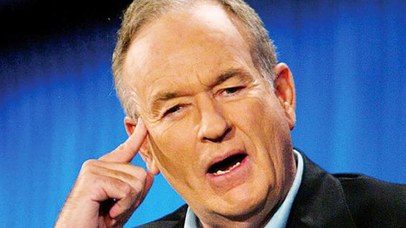 Bill O'Reilly Bill O'Reilly Now O’Reilly is on “Italian vacation” HE HAS BEEN FIRED. His general hardline racist, sexist, nationalistic preaching and colourful untruths, have been his style for two decades. Rupert has always surrounded himself with alpha male, macho, chest beating blokes. Even though he is a slightly fey figure, he has used raw, masculine, forceful personas who exude “tough” man power for fifty years. Very few women executives and lots of testosterone. Enter James and Lachlan. They, according to reports, have said to dad – no more O’Reilly. Enough. What prompted this rebellion God only knows!! Advertisers fleeing I would suggest – but maybe a little more also. The era of Rupert, at 85 or so, may well be at an end. He has exploited long enough. The sons have realised (der) that obscenity, sexual predatory behaviour and insults are not acceptable to the sensibility of Fox viewers. O’Reilly’s reported replacement is Tucker Carlson, a soft, flabby, boyish 50 year old, with a vacant expression and the style of questioning of a teenager. He is suitably dim and parochial but will fit well with the bereft audience. He will be inoffensive because he is not a sexist predator. Fox may or may not regain advertisers. Rupert has extended and promoted his version of sexual inequality for far too long. His company will still promote other social divisions such as racism, but this is a significant moment with the removal of one of the last great bully boys ranked as a leader (by O’Reilly himself) in US media. Change happens in an interesting way usually triggered by an inconsequential moment. Murdoch’s sons could be the catalysts this time. But maybe it was just one more woman too many, reporting that O’Reilly’s insignificant member was being fondled in a phone call to her. She brought charges against him. The doyen of the sexual bully set is exiting right. The dirty digger is getting a pounding in the Big Apple. We should breathe a sigh of relief. He has sullied Australia’s name and has exploited gross sexism worldwide for far too long. Elizabeth’s little boy Rupert has finally done his dash.
1 Comment
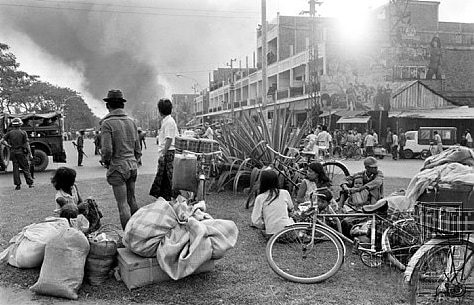 Phonm Penh, 1970 Phonm Penh, 1970 In late January 1970, I set out from a Cambodian border post, rucksack on my back, to walk across a barren stretch of dirt, several hundred metres wide, towards the Thai border—No Man’s Land. I recall the earth beneath my feet, the sensation of time slowly passing. With each step, it seemed, the Thai border was receding. I was exposed, a sitting target, caught within the sights of guns, pointing from both directions. The silence accentuated my sense of fragility. This stretch of land seemed like a place in which birds had stopped singing. In a sudden rush of madness, I was tempted to stop, mid-walk, lay down my pack, and set up camp within sight of the two borders. I was relieved once I reached Thailand and negotiated the customs procedures. No one, however, could have foreseen the horrors about to unfold in the country receding behind me, the chain of events that would culminate in the Killing Fields. I had the luxury of moving on. There would be no such luxury for the citizens of the country I was leaving. To understand how I felt back then, we need context: At that time war was raging in Vietnam, alongside a ‘secret war’ in the north, in Laos. For the past month, I had travelled through both countries. In Vietnam: I witnessed the chaos of war, the scarred landscape, the frenetic streets of Saigon, the pavement shantytowns, refugees congregated in vacant lots and sidewalks, bands of amputees, gangs of street children, allied soldiers on leave and the brothels and bars that serviced them. Young men sent to war—the fear in their eyes, their lethal bravado. The madness. There were ten thousand Australian troops in Vietnam back then. Upwards of half a million US troops. Twenty-year-old Australians were being conscripted. My name did not come up in the birthday lottery. Instead I travelled on a journalist’s visa, issued in the Vietnamese embassy in Bangkok. I had hitch-hiked north-east through Thailand, overnighting in towns that serviced US bases from which B-52s set out on their bombing sorties. I crossed the Mekong to Laos, where that secret war was being waged. Vientiane was a city of refugees fleeing the bombing. I flew to the southern city of Pakse, and to Saigon, in a rattling DC3, flying low over a scarred landscape, borderlands subjected to carpet bombing. Carpets: evoking images of beauty and softness—a euphemism for carnage. Arriving in Phnom Penh, weeks later, from war-torn Saigon was a relief. Back then, it seemed, Cambodia was an enclave of peace, bar the not-so-secret US bombings on the Cambodian-Vietnamese border, ostensibly to destroy Viet Cong hideouts. Sihanouk appeared to be the undisputed leader—jazz saxophonist, film director, actor, script-writer, composer—founding father of the republic—a dilettante for all seasons. Playing off all sides to remain neutral. Presiding over a low-rise city, graced with French style boulevards, stuccoed buildings and villas, built in the image of its former colonial masters. But the peace was deceptive. Forces were building. Foreign powers and their proxies were vying for ascendancy. The US and China were jousting in the shadows. A military coup was imminent. Sihanouk was about to be overthrown, and the CIA backed Lon Nol about to be installed as leader. A civil war was brewing. This context puts the walk over No Man’s land in perspective: That barren stretch of land was, paradoxically, an enclave of sanity. There, at least, all was reduced to the human— stripped of tribe, nationality, disparities in wealth, and class distinctions. Stripped back to a kind of essence. It was also, however, very dangerous. Just one trigger nervous guard, just one incident, one misunderstanding, and shots could be fired. In recent times my thoughts have returned to that stretch of dirt. There are many No Man’s Lands today—some literally a physical space between countries. This physical ‘no man’s land’, can also include those tiny patches of pavement, occupied by homeless people in the streets of our own cities. The state of living in No Man’s Land can be a matter of legal status. There are 10 million people currently defined by the UNHCR as ’stateless’ — people denied a nationality and access to basic rights such as education, healthcare, employment and freedom of movement. Closer to home there are the 2000 men, women and children, now marooned for upwards of four years on Nauru and Manus Island, and upwards of 30,000 still living in limbo on mainland Australia, on various forms of bridging visas, their future undecided. Many more languish for years in refugee camps—displaced people’s in search of new lives, asylum. We are now witnessing the highest levels of displacement on record. According to recent UNHCR figures, 65.3 million people worldwide have been forced from home. These include 21.3 million refugees, over half of whom are under the age of 18. I return to that moment, back in late January 1970, that mad impulse to set up camp as an act of defiance. At a time when an increasing number of leaders proclaim we are going to make our nation great again—pointing the finger at outsiders, ‘the other’, at refugees and immigrants as the source of their nation’s problems—that barren stretch of land, can be seen, paradoxically, and symbolically, as a place of pure being, where all is reduced to the sound of one’s own heartbeat. There is nowhere to hide in No Man’s Land: all is so achingly and transparently human. If you enjoyed this piece by Arnold or have a comment to make just click below and join in. Men behaving badly, none so much as America’s top soldiers 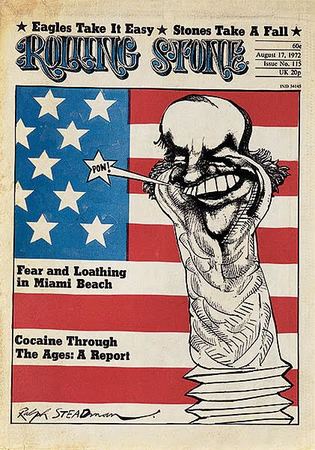 Phillip Frazer This year, Rolling Stone magazine is celebrating its 50th year on American newsstands. It’s also 45 years since I launched the Australian edition, still going strong. Back in 1967, I was publishing a pop-music tabloid called GoSet, selling 70,000 copies a week across Australia. America had no nationwide music paper until late that year when a uni dropout named Jann Wenner started Rolling Stone. Jann and his writers, designers, and photographers believed that, more than fun dancing music, rock n roll was an expression of an emerging youth culture that would change the world. In 1970, I stayed for two weeks with Jann and his wife Janie in San Francisco, and apart from having fun we made a deal that I would publish an Australian edition, launching in January 1972. Working out of a group house in Glebe, a few mates and I coaxed the Aussie Stone toward sustainability then, in 1976 I sold the Australian franchise to a trio of Sydney gonzo publishers and moved myself to New York. My interests were in political, environmental, and cultural upheaval, all of which I was in favour of, so I kept up with Rolling Stone during my New York decades through occasional encounters with Wenner and by reading the infrequent outside-the-box political stories he published. On this 50th anniversary of Rolling Stone, these few major stories from the archives stay with me: Tom Wolfe’s radical chic. When I arrived at the Wenners’ home in 1970, that night’s real dinner guest was Tom Wolfe, the writer of four books with long titles such as The Electric Kool-Aid Acid Test. Jann and Tom talked about The Brotherhood of the Right Stuff, a story about American astronauts that Tom was writing for an upcoming issue of Stone, with photos by Annie Leibovitz on the biggest assignment of her nascent career. Wolfe’s stories, dubbed “New Journalism”, were rich in lively descriptions of characters, places, and cultures in motion, and major critics of media and literature loved that he inhabited the tripping brains of the heroes while containing them in a well-woven story. Given where we are now in terms of fact/fiction/faction, Tom might have been a mixed blessing to journalism. Fear and Loathing. When we launched the Aussie Stone, Hunter S. Thompson, the chain-babbling trasher of all cultures, was cranking writing genre-bending up a notch with his epic reports on the 1972 US election and on convention events in Las Vegas. HST and his Samoan attorney (actually Mexican) famously travelled with suitcases of booze, pills and white powders, while attempting to unravel white racism toward Latinos. Thompson did a great job of trashing the suit-wearing, over-eating, know-nothing guys who run much of America, but his ferociously first-person reportage also may have inspired a million online ratbags. The reporter who died after killing the General’s career. In 2010 Michael Hastings, a 30-year-old freelance writer, spent time on the road with General Stanley McChrystal whom President Obama had put in charge of the US war against the Taliban in Afghanistan. McChrystal and his support crew let Hastings into diplomatic meetings, late-night booze-ups, and heavily armed visits to alienated Afghanis and disillusioned GIs. Hastings’ story for Rolling Stone faithfully reproduced the General’s no-bullshit repartee with everyone, making it stunningly clear that McChrystal and his fellow top brass were appallingly full of shit -- also ignorant, arrogant, crazy violent, and destined to fail at saving Afghanistan. After Obama read the article, he fired McChrystal and backed away from his “strategy” of having troops occupy villages to hunt down insurgents while uplifting the good citizens. US military and intelligence honchos don’t like being discredited by journalists (or black Harvard-educated Presidents), and they may have had a role in Hasting’s violent death in June 2013. Last month Wikileaks leaked documents on how the CIA can remotely control recent model cars. Hastings’ Mercedes hit a pole at full speed on a suburban street in LA at 4:25am. Yes there is a theme in all this – it’s all about men behaving badly, sometimes the writers themselves. Jann always tilted his magazine strongly toward men as contributors, and readers (66% male). In a list of “50 notable current and former staff of Rolling Stone” on Wikipedia, there are only three women. One is a music journalist, one was publisher for seven years and is not well-remembered by the company, and the third is Sabrina Erdely, who wrote the notorious Stone investigative piece titled A Rape on Campus in 2014 which was subsequently adjudged profoundly flawed, costing Wenner Media millions of dollars in multiple defamation and libel cases (still ongoing). I put Hastings’ revelations about just how crass the Masters of War really are at the top of Rolling Stones’ journalistic achievements. Me, I’m a little bit glad Wenner has published Stone for all those years -- and glad I didn’t. Footnote: Jeune Pritchard interviews Phillip on ABCTV in January 1972, about the showdown with Rupert Murdoch’s Southdown Press over the launch of the Australian Stone -- HERE _____________ Phillip Frazer still inhabits the mid-Pacific miasma, but on most days he sees clearly now, from coorabellridge.com 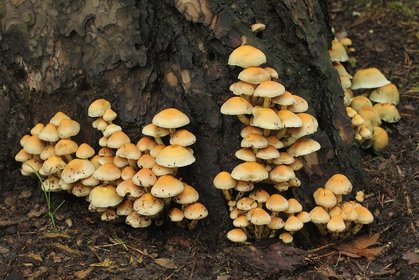 British wild fungi British wild fungi George Biron has been a chef in some landmark restaurants that he has owned or worked for, His Sunnybrae Farm near Birregurra was always a pleasure to visit as the farm style rooms and the freshly picked home grown food formed the basis of a wonderful culinary experience. My introduction to the cooking of wild fungi began in the early eighties in London where ceps, chanterelles, morels and other wild fungi were quite commonplace on restaurant menus. A decade later when we opened our restaurant Sunnybrae near Birregurra I was privileged to employ a young chef Craig Creasy who had been introduced by another older French chef to wild edible fungi growing in Australian that are quite common in the forests in and around the Otway ranges in Victoria. So began a passion for foraging for wild edible fungi. The notion that we are still a largely a white Anglo-Australian fungi phobic community has changed remarkably in these three decades. I believe we are now, due to the enormous interest in food and cooking, a largely neophillic society actively seeking out the new and exotic food experiences. An extreme manifestation of this lust for the new in relation to edible fungi has even seen Cordyceps used on Masterchef! [season 7 episode 52] with virtually no background or explanation. FFS? I wonder if Coles was inundated for Cordyceps after that episode? As we were also a cooking school I began to host fungi foraging excursions and fungi cooking classes often with expert guides. I did this as much to expand my own knowledge as for the benefit of the others on the hunt. I bought as many books on the subject that I could find and began a study that still fascinates me now. These trips ended with a meal made with our finds on the day. Many farmers’ markets and seasonal restaurant menus abound in the sale and use of wild fungi but in Victoria it is mainly two common varieties Saffron Milk Caps, Slippery Jacks and their variants. In South Australia large flushes of Boletus edulis in recent years have also entered the trading mix and are being seen at Victorian and other interstate markets. I have also seen Wood Blewits, Horse mushrooms, morels and a few other varieties offered for sale in markets and used in restaurants. In the forest I often encounter people from European and Asian backgrounds and also young and older Australian foragers picking all sorts of other fungi that I would not consider edible that they are familiar with and were comfortable with and using in their cooking. And I don’t mean the trippers although they are all also there. While some of these hunter gatherers have solid experience I have also seen baskets full of mixed fungi picked and disturbed by amateurs just because they look “cool” The more I learned about wild fungi, its relationship to the environment and the dangers of indiscriminate foraging the more careful I became. There seemed to be an endless public appetite to learn more about fungi and especially edible fungi but there were very few if any in depth courses run by experts that were available. Eventually I gave up hosting forays even though they became more and more popular. The last forays that I conducted had the most experienced guides I could find to minimise the risks. I eventually realised even though we were very clear in our warnings someone who had been on one of our forays could inadvertently make a mistake and suffer the consequences. I also began to fear that an inexperienced forager-chef could after one of our classes mistakenly use a dangerous mushroom on a restaurant menu with catastrophic results. I realised that a short half day foray and cooking class was just not enough. The other day while having lunch at my local café in Kyneton my partner alerted me to an interesting wild fungi exchange going on at the back of the café. I wandered out the back and discretely inquired as to what the fungi being discussed was? The forager was trying to sell truffle like fungi to the cook. It looked like a type of Melanogaster? I did not know what it was. On further inspection the smooth exterior rang warning bells but to an untrained eye the cross-section could easily have been mistaken for a black truffle which it was very clearly not. I gave my two bobs worth and suggested they do a bit more investigating before thinking about cooking with it. The interest in all wild foods is undeniably increasing as is the interest in sustainable living and I believe we have an opportunity to develop a series of courses run by academically trained and professionally experienced people to promote an ecologically sound guide to fungi foraging in Victoria. The bulk of wild fungi sold into food service comes from private foragers selling directly to restaurants or to larger aggregating provedores. Farmers’ markets also sell a lot of wild fungi that is often in less than optimum condition. I believe the managers of these organisations would embrace courses of this nature for themselves and their buyers. Commercial foragers who I have spoken with, who also have a professional attitude to this activity, are very keen to be able to gain more experience in this area to safeguard their clients and their livelihoods. I have also spoken to Matteo Pingnatelli the National President of the Restaurant and Caterers Association who is also keen to see such courses being made available to his members. On the other hand, as a lot of this activity is taking place in the cash economy and there will be resistance from that quarter but I believe if such courses were available, provedores, executive chefs and Farmers’ market managers would only be too happy to buy from dealers who have been through such a course. I am not suggesting compulsory accreditation but commercial foragers who have been through these courses would become the preferred provider leading to a growth of knowledge and would develop a deeper respect for the environment where they grow. Interest in these courses will also come from many private individuals who have a strong interest in cooking, ecology and conservation. Rather than create a “gold rush” like culture that has developed in some parts of Europe and the United States Europe an ordered well conducted series of fungi education courses would be able to explain the ecology and special relationships that fungi have with the environment and confront the limited knowledge that we have about the edibility of native fungi. Out of such courses and the interaction created with people currently consuming “not documented as edible” fungi can only add to the growing wealth of knowledge that academic researchers are undertaking. The confirmation of the edibility of wild fungi is a very complicated area of study but the provision of solid well researched and delivered courses to understand the subject and the limitations of current knowledge can only direct this fascination for wild foods in a positive direction. 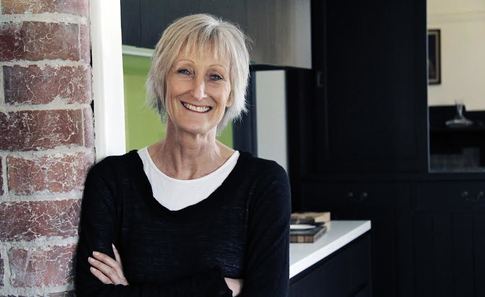 Rosie Jones, Director Rosie Jones, Director Bob Weis It's funny how connections work. I had seen Rosie Jones' marvellous film "The Family" on Monday and told her I was going to write about it that night. In fact I wanted to let it sink in while the various connections and reverberations kept coming so I decided I would do it after my usual Tuesday morning swim. On the way to my car from Il Fornaio after breakfast I ran into Rosie's partner, Peter Tapp, and commented that I had seen the film and how much I liked it. Then Robert and I drove off to get his car from Mary St. We were chatting and as I had done a thousand times before signalled my turn from Park St to Mary St at the roundabout and almost got through it when a deafening noise accompanied by the side air bags and a swerve of the car alerted us to the tram that had hit the car. I was in shock, I now realise, and pretty soon I was being led out of the car by Robert, my swimming partner, and told to sit on the ground and an ambulance was called as well as a tow truck. Pretty soon there was a crowd with all of the above, the car stuck on the roundabout blocking trams in both directions and now three trams sitting there immobilised. Two policewomen from South Melbourne station attended and they couldn't have been nicer or more helpful. The ambo paramedics got me into the ambulance and cleaned me up, I had some blood from cuts around the nose and under one eye and eventually Robert drove me to my doctor who I was due to see but was running late for now! She took me in straight away and did all the tests to make sure I had nothing broken and that I had no internal injuries or bruising. Blood pressure and so on. Finally I got home and thought about writing this piece but then though better of it. When I was watching the film it brought back to me something else. In the sixties I went to Monash University and in my second or third year met Cypra Helmer and friends of hers As it turned out I had come across her brother Michael who was at Scotch College when I was at Caulfield Grammar and although I didn't know him well we did both belong to a wider friendship group. My one abiding memory of Michael was him facing me as I bowled him out in a school cricket match and him refusing to walk after the umpire raised his finger. No big deal. He was annoyed. Not out!! Cypra was a tall willowy young woman who was high spirited and loved to chat and laugh and sing. I don't think she finished University and when I did I went to London to go to film school so it was probably the early seventies by the time we caught up again. She had a few musician boyfriends and I think also went to live in London for a while with one of these who it was said was physically abusive to her. In any case by the eighties we had drifted apart and she was becoming, by reports, more involved with drug taking and behaving erratically. The sixties lifestyle, sex, drugs and rock and roll, was embraced by most of us but some didn't see the onset of latent problems. In 1988 I was shocked to hear that she had died after jumping from the top of the Trak building on Toorak Rd. She was naked and there was a note. She had been diagnosed as schizophrenic before this some time before this event but I hadn't heard about the involvement of The Family at this point. I also don't know if it was a Family doctor who had made the diagnosis, As is Jewish custom I went to the home of mourning that night which was Cypra's parent's home also In Toorak Rd. The parents, Maurice and June were overcome with grief. Cypra's two brothers were studies in opposite reactions. Her elder brother John said to me "what do you think happened?", and I was too shocked to answer only having heard the mental illness suicide version at that point. Michael on the other hand looked calm and smiled the beatific smile that was on display in Rosie's film where he was the only sect member who spoke positively about Anne Hamilton-Byrne. He said, "she's gone to a better place" and continued smiling while holding my look which must have been one of complete disbelief. Rosie has crafted a feature length documentary that thriller or film noir style takes us through the setup of the cult that became known as The Family through reconstructions, interviews with both survivors and the two main policemen, Lex de Man and Peter Spence who led the task force and whose lives were changed and affected by the four year process and which still showed through years later both in the film and in the follow up Q&A at the Melbourne Film Festival following the screenings - of which there were four after the scheduled two had created more demand. As it turned out I saw it at the Nova at a 1pm screening that was so full that the seat I had been removed for a wheelchair at a previous screening and so I saw the film from the discomfort of the stairs. Anyway the film was so engrossing and disturbing I noticed the postural issues less than the horror story unfolding before me. The end credits revealed two more connections. I was on the Council of the national film school, AFTRS, and one of the two student reads on that council was Anna Grieve the Producer. Anna showed then that she was and is very bright and had great values, and the film was beautifully shot by James Grant who I met when he was a tertiary student and then we worked together on Pure Shit which I produced and he was the camera assistant for. Round and round. Rosie came to directing from the cutting room and has made a number of films now. The previous doc of hers that I saw was a chronicle of the community battle in St Kilda with developers and the Council against the Triangle development next to Luna Park, a battle which was ultimately successful and which saved the Palais and the site for community use. The film was inspiring and as a long time resident of St Kilda it was a boost to my love of the place. The film was The Triangle Wars and I recommend it too. 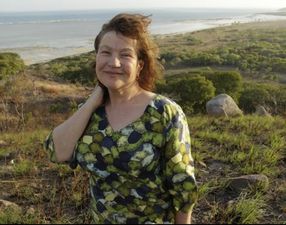 Anna Grieve. Producer Anna Grieve. Producer I don't want to say too much about the film but do urge you to see it when you can. Having said that, as the film establishes, the sixties threw up a lot of gurus and followers in all kinds of flavours. Hamilton-Byrne was a self described reincarnation of Jesus Christ and among her early devotees were academics, psychiatrists, doctors nurses and social workers all of who made it possible for her to "adopt", legally at the time, children who were died blond, dressed the same and indoctrinated to the point that even when it all came crashing down some, not many, spoke in her defence but none as forcefully or as devotedly as the now Michael Stevenson (Helmer) did in the film with that same beatific smile he showed the night of Cypra's mourning. Hamilton-Byrne gave new names to her disciples too. One thing Cypra had told me was when she went to visit Michael in (I think) the Gold Coast one of his Anne H-B's chosen wife for Michael's children was trying to escape and this child was afraid of him in a genuinely terrified way. This was third hand at the time and that was nearly forty years ago. He is in the film and Rosie says is doing OK considering. I remember a post card I got from an old University mate in January 1980. The note on the card read "the year 2000 is now closer than the year 1960, Philip". Aye to that and a lot more. Bob Weis I read Magda's book on my iPad and it is available from the iBook store. I read it in the period over the past year or two of reading memoirs including Oliver Sacks, Jenny Diskin, Caro Baum and now this. Magda Szubanski was born 12 April 1961 in Liverpool, Merseyside, England. Her mother Margaret is Scottish-Irish and came from a poor family. Her father, Zbigniew Szubanski, came from a well-off Polish family and, as recorded in the Official Archives of the Warsaw Uprising Museum, was an assassin in a counter-intelligence branch of the Polish resistance movement in World War II. She attended high school at Siena College, Melbourne, and later studied fine arts and philosophy at the University of Melbourne. In 1976, as a year 10 student, she captained a team on the television quiz It's Academic. - Wikipedia entry What the Wiki entry for Magda doesn't say in as many words is that she is a multitalented individual with abilities across a number of disciplines that most of us don't possess or even come close to hoping to have. 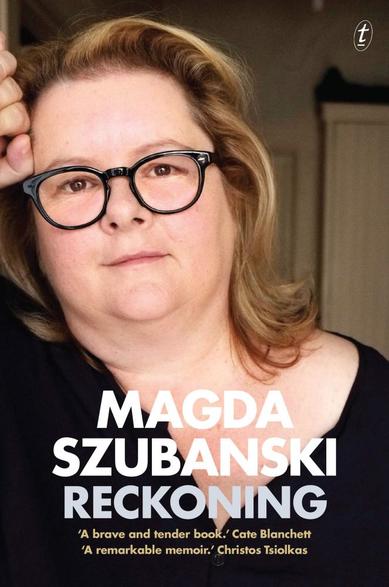 Her memoir, Reckoning, takes us into a darker and more joyous search, as well. Magda, like many immigrant kids, had to navigate the rough eddies of trying to fit in to a new country which despite the rhetoric is not so kind to the New Australians - while also trying at first to name and then to own her sexuality as well as trying to unravel her father's secret past in wartime Poland. The surprise for me in reading this book was the ease with which Magda wrote it and her skill as a storyteller which has been on display on stage and screen for many years. Writing is a solitary and difficult task - confronting your demons and doing it with eye watering honesty is something else again. Magda knew from an early age, or suspected it anyway, that she “liked” girls. She tried boys and tested herself and the journey she went on makes compelling reading. Her father was a bit of a closed book in terms of talking about the past, something I can relate to as mine never spoke about his past. Our history was in Australia though he never lost his nostalgia for Europe and while he could he travelled there every year but never back to the Poland where he was born. I gave up trying to hear from him what his life was like there as he would always divert that conversation to soething else or not answer at all. I went to the then-recently opened Holocaust Museum in Washington and looked through their testament database. To my surprise I found a testament deposited by a woman living in Brooklyn who shared a maiden name with dad's mother, Bagelmacher. An unusual name. Could they be related? I excitedly rang dad who was in Jerusalem at the time and said, “Dad I'm at the Holocaust Museum in Washington and found a testament here by an American woman with the same surname as your mother.” “What's the weather like in Washington?” Magda's book also surprised me in the fact that it was a box of tissue read with damp eye moments as well as full blown grief and sadness. It's almost a cliché to say that great comedy comes from tragedy but there it is. Magda had the great benefit of a family that were totally for her. Her brother and sister were important supports to her coming out to her parents who were both loving too. I don't want to give too much away as you will get enormous pleasure and a full range of emotional responses from reading this book and I would be very happy indeed to be as good a writer as Magda when I grow up. 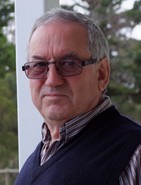 Trevor Colvin Trevor Colvin The iconic image of a young man in a white shirt defying an army tank in Tiananmen Square went ‘global’ long before social media existed and is etched into the minds of millions. He was the embodiment of protest; and hundreds if not thousands of his colleagues died in Beijing during that protest in 1989. In Australia we had Albert Langer from Monash University fomenting protest against the Vietnam War. He was prepared to go to jail for his beliefs and for years he was the face of protest in this country. Protesting the same war, four students at Kent University in Ohio gave their life for the cause. In Orangeburg, South Carolina three students protesting for civil rights were killed for their beliefs. And so it has been. Students across the world – USA, UK, Europe, Malaysia, China, South Korea and many more have led protests and have been prepared to die for their beliefs. They made a difference. Protests ended American and Australian involvement in the Vietnam War. Protest – again often initiated by students - brought massive improvements to the lives of America’s blacks. Massive social change came about in France through student protest late last century and going further back, protest led to the French Revolution in 1848. Throughout the ages it seems when people protest, changes can follow and often do. Without protest, the status quo remains. The insidious may not be exposed and social wrongs not righted. Protest was the domain of university students for several reasons. They were young and their minds fully into enquiry combined with a thirst for knowledge and expression. They were passionate in their beliefs which hadn’t yet been blunted and dented by time. They generally had a strong social conscience and truly cared about their fellow man. They lived in a learning environment which encouraged critical thought and debate. Lost Cornerstone Or at least it used to encourage critical thought and debate but we have dumbed that down. The beginning of this downward spiral came with the introduction of fees for university education. Students found themselves in debt for their education and no longer had the luxury of spare time to think, to connect and to debate, instead studying hard to get a job to pay for the debt their education incurred. It was a vicious cycle which took away the student collective concept. Over a relatively short time universities were full of individuals with little time for each other and thus little time for the fomenting of ideas. We have also seen a general falling in our education standards, Australia slipping to 28th for year four maths and 25th for year four science since 2011. It seems apparent that the teaching fraternity, from primary, through secondary to tertiary is much more focused on social politics than on education than it should be and this is developing a student class with different values to their predecessors. It is not just education that defines the current student body as different of course, but education is a critical factor. We are not equipping our students educationally as well as we did and also we are effectively denying them space they once had to think and develop and it is hard to find anything positive in this. Our educationalists have created ‘safe spaces’ for students to go if what they hear may offend them. Here is just one example. A visitor to Brown University in the US was coming to give a lecture and a ‘safe space’ was established to give students and others who might find her comments troubling, a place to recuperate. The room was equipped with cookies, colouring books, Play-Doh, calming music, pillows, blankets and a video of frolicking puppies and students and teachers to assist with counselling. Entire dormitories have been determined ‘safe spaces’ even college newspapers and ‘safe space’ simply means discussion is off the table, let alone any debate. This development is not confined to America of course. So, my question is; does today’s student body have the wherewithal for critical thinking and I suspect they don’t. And if they don’t where will the winds of change blow from if not from a passionate student body? We are currently in a world where a dark-ages religion based, on ignorance and hatred is trying to engulf the rest of the world and many people in all societies and all levels of society can’t or won’t see the threat this poses. Thirty years ago this topic would have been hotly debated at university and college campuses, opinions formed and actions developed. Students would have been extremely active in analysing the situation and bringing it squarely into the public space for discussion and debate. It frightens me that this is not happening because traditionally students have been at the forefront of fresh thought and often brought the rest of society along with them. They were a vanguard for change. Such change doesn’t come about by hiding under a blanket eating cookies in a safe place and sipping warm milk. Although never personally a protestor, I respect the value student protest can bring to democracy and the difference it has made and I know we are a lesser and more vulnerable society for effectively eliminating it. I don’t know if the brave young man who took on the tank in Tiananmen Square was steamrollered that day, but I do know that with the absence of a critical student body it will be easier for anyone or anything to steamroll your world and mine. Trevor Colvin studied communications at RMIT while working in the advertising industry and later 'The Age' where he developed into number of senior roles including a five-year stint in Asia publishing magazines and the first national English-language daily newspaper in China. Colvin left the corporate life and over time began three separate and diverse businesses. In the past three years he has taken on a new role as movie producer and is enjoying the challenge and the steep learning curve. Join the conversation by clicking here and have your say by leaving a comment, question or whatever you wish. Comments will be moderated.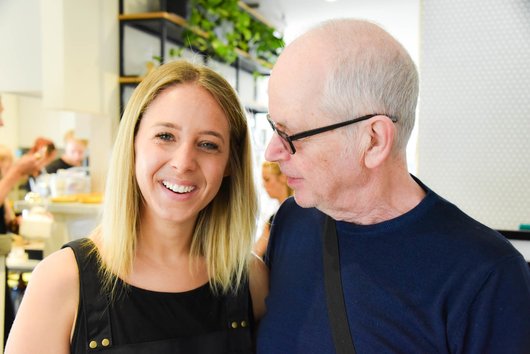 Emillie Hazell and Bob Weis Emillie Hazell and Bob Weis Bob Weis In my experience, and increasingly in that of many other Melburnians and travellers, it is the name of a complex, in the Burnley area, which includes a restaurant, gym and wellness centre and all the creation of a remarkable young woman, Emillie Hazell, 26. When you walk into the restaurant, Serotonin, you are greeted by any one of the staff and if you are lucky taken to a table. The first time I went I thought the staff were impossibly friendly and nice but over time I realised that it is genuine because the people who work there are proud of what they do and confident of their product, the food and the environment. The menu, in typical Emillie fashion, is not only by and large vegan it is also local, organic and complex. So no white flours, white sugars or processed foods. The food is tested in-house before ever being served to paying customers and Serotonin has scientific advisers who have an input to the final product. 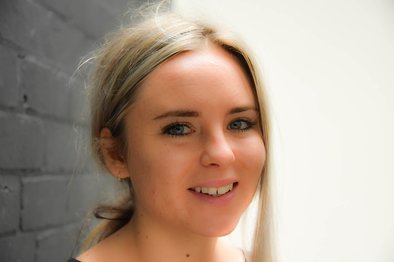 Stevie Scott Stevie Scott Stevie Scott, a one of the Serotonin Originals, has always been welcoming and sunny but yesterday she was at university at her course and someone I had never met waited on our table and was warm, friendly and helpful. So no coincidence but a pattern. Serotonin is also, of course, a complex neurotransmitter found in human and animal bodies and the amount of it in any particular individual is thought to be a marker of that person's feelings of well being on the one hand or depression on the other. It is not the whole story of depression as the Prozac boosters believed when they first went to that drug first went to market. A lot of people were prescribed Prozac and other Serotonin re-uptake inhibiting medications. Books were written about the new magic in combatting depression. Emillie in her own words had “mood funks” when she was fourteen. Not unusual for a teenage girl. When she was twenty and now diagnosed by her GP as depressed she was told that the treatment she would now start on was medication followed by psychotherapy. Emillie said “no thanks”. She had been doing her own research and decided that she could defeat the problem with a plant based organic whole food diet, exercise and meditation. By the time she was 24 she had a business plan and a way forward but she was no longer depressed or in need of chemical help. In the short time since the businesses have grown to such an extent that the gym behind the restaurant has been moved to Camberwell and that space converted to a function centre for larger table bookings and events. The restaurant will soon be open for evening meals as well. It already does Uber Eats which will deliver you a great meal - I availed myself of one the other night. 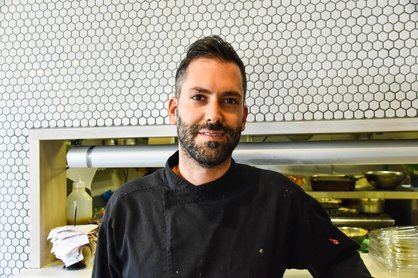 Chef Moshe Itta Chef Moshe Itta aHer partner of seven years, Daniel Dundas, glows with pride as he talks about Emilies achievements. “You have been there from the beginning of this journey”, I comment. “yes, but all the planning and design came from her”, he says. Not many men will admit thus much in their need to be top dog. Have a look around the Serotonin site and click on the various options. It will be rewarding but definitely go there and have a great meal. Disclaimer – I have no shares or financial interest in this business. I have had an interest in depression and other forms of mental problems for quite a while. My father had clinical manic-depression and the family saw him go through the stages of mood changes, major depressive episodes, hospitalisation and finally dementia. His case was complicated by his personal history – he was in six slave labour camps during the second world war and he never really got over the murder of his mother, grandmother and younger brother. How could you? Over the years I had proposed an observational documentary series for tv that would go in depth with three or four individuals coping (or not) with different problems. I had wonderful input from my school days friend, George Szmukler, who was then the Head of Psychiatry at Kings College, London and David Copolov, the founder of the Mental Health Research Institute in Melbourne. They in turn put me in touch with other professionals and then with clients. It was an intense period but the tv networks were doing their own things with the ABC and Andrew Denton and the BBC with Stephen Fry. In the end I never got to make this series but I was glad that the issues were raised and I certainly got a lot from doing the research and probably got a better understanding of my dad's issues. Finally back to Serotonin the cafe, I was there again this morning with my grandson who loved the pancakes. Emillie has created something wonderful for a growing community,
Join the conversation by clicking here and have your say or leave a comment, question or whatever you wish. Comments will be moderated. I met Trevor a couple of years ago to talk about a project he initiated - a feature film about Sir John Monash a history he knows an enormous amount about. In the course of developing this exciting feature film I got to know a bright, passionate and very polite and thoughtful man. I am pleased to have got to know him and happy to see his writing here. - Bob Potential Missed Trevor Colvin Trevor Colvin Back in 1991 the “Iceman” was discovered in the snow high in the Alps on the Italian/Austrian border. His well preserved body was more than five thousand years old. Who was he? How did he live? What did he eat? What could he tell us? What could we learn from him? The world was quite excited, as was I. It was crushingly disappointing, but unfortunately not surprising to learn two years later that he had been killed with an arrow in the back. How I had hoped he had died from natural causes, or fighting off a predator, or from experimenting with a food source; but alas, he was murdered. The oldest naturally preserved body in Europe was a victim of foul play at the hand of another human being. It is generally accepted we ‘evolved’ from ancient ancestors to our modern form around 200,000 years ago and there is evidence of a skull from China believed to have been crushed by another human, that is almost that old. It seems we have been bashing each other to death for as long as we have been standing on two feet. For me it begs the question ‘why’? Given the amazing brain we have developed we had the potential to be the greatest of creatures – a magnificence – a guiding and protective light for other creatures on the planet and perhaps beyond. How and why has humanity failed to get even close to its potential is the question I am asking and readily confess I don’t have the answer? It is a question that has been asked before of course, but I haven’t seen an answer that has any real currency. I am not talking about individual magnificence, because many humans do rise above these limitations and there are plenty of self-help gurus urging us to discover our untapped potential, but they are dealing with individuals. Why, as a species have we failed? We have the capacity to truly love and feel compassion for other creatures with which we coexist, and yet we raise them to slaughter them cruelly for our own ends. We can understand the complex argument that a butterfly fluttering its wings in the Amazon, can affect world-wide weather and yet we daily destroy this delicate balance in almost every way we can. While some of us are bombing others to death on a daily basis, others among us choose to put their own lives at risk among those same bombs, bodies and debris, trying to patch up the broken and the wounded.
We have had a long time with a very sophisticated brain to have worked out that we are not living to anything like our potential, so what is missing? Is it as simple as blaming ‘God’ whatever or whoever that might be? Billions of humans believe in some form of God and the reasons given for God’s failure to intervene is that we were given ‘Free Will’ – meaning we need to sort it our for ourselves. Is it as simple as blaming greed and self-interest? At any given minute in any culture anywhere, there are millions of people exploiting others. The trough is full enough for all snouts to feed well, but the few push the many away. Does the lowest common denominator determine overall outcome? There is no doubt we humans have varying degrees of intelligence and the most intelligent are in the minority so does this mean the less intelligent majority overpower the more intelligent minority? Sounds reasonable but the counter argument would be that the more intelligent should be able to outwit the less intelligent. Is it as simple as us not being fully ‘connected’ yet? We are all aware of telepathy and almost everyone on the planet has experienced it at some point. We are all aware of the ‘Hundredth Monkey Syndrome’; and I hasten to add many scientists debunk it. But if it is real, are we simply not all on the same wave-length yet and that given time we may become as one mind. Even if that were to occur, there is no guarantee it would be a benign mind and given the dark ages we currently seem to be revisiting, the benign version looks unlikely. A common put down for bad behaviour is to say he or she or they ‘behaved like animals’ referring of course to non-human animals. The pity is that the world might be a better place if we did behave more like ‘animals’ than humans. Trevor Colvin studied communications at RMIT while working in the advertising industry and later 'The Age' where he developed into number of senior roles including a five-year stint in Asia publishing magazines and the first national English-language daily newspaper in China. Colvin left the corporate life and over time began three separate and diverse businesses. In the past three years he has taken on a new role as movie producer and is enjoying the challenge and the steep learning curve. I got Caro's book downloaded on my iPad as a Kindle for Mac ebook. I am not going to spoil your pleasure in reading this wonderful piece of writing other than to say I couldn't stop reading it once I got started and it is engrossing, engaging and emotionally and intellectually formidable. I met Caroline in 1981 or thereabouts when she came to interview me about Women of the Sun. She immediately struck me as well researched, bright and engaged in a way that some of those who did interviews weren't. Over the years I saw her go from print to television and to live writer's festival events with important writers from all over the world. There seems to be a rash of memoir writing or maybe I have just been reading memoirs a lot more than I ever did. I had dinner with a friend last night who is almost through writing one and we talked about Caro's book and also Oliver Sack's memoir that he published shortly before he died. Sacks also kept a journal that was published in the New York Review of Books in every issue after he realised that he was going to die until he did. As did Jenny Diski in the London Review with her cancer diary. Her memoir of growing up in 1960's swinging London and being fostered by Doris Lessing was riveting reading but disturbing and disturbed. I came close to meeting Sacks once. Caroline was doing books on tv for the ABC and asked if she could use my house in St Kilda for a location. Sure, I said and promptly forgot about it. On the day I got home and I heard something upstairs. When I quietly approached there was Sacks sitting facing Caroline in mid interview so I went further upstairs and waited until it was over. Finally he left and I came down to talk with Caro and see how it went. "You know he was wearing a shirt exactly like one of mine," I said. "It was yours, he came on his motorbike and his T Shirt was covered in grease and I told him he couldn't do the interview looking like that so we went up to your dressing room and chose that one". Getting back to Only it is an incredibly brave thing to have written. Writing about yourself and your history is hard enough but crossing over to the other side when your professional life has been about other people's work and careers and understanding that perspective must not only have taken mental agility but also the courage to make yourself vulnerable and open. The book succeeds beyond and over .. Caroline has always set the bar high for herself and you will see why from a reading of the book. This book meets that high standard of expectation and rewards the reader with its frankness, playfulness and above all its unblinking honesty. There is pain as well as joy and the family dynamics are described without sentimentality or gloss. Caro was always a very generous interviewer and would not wing her way through The cover has quotes from Magda Szubanski whose memoir I am now reading and Helen Garner who doesn't give praise lightly. So, much to read but put Only at the top of your list. You will love it too. Here's an interview with Caroline Baum on ABC (mp3 below) |
 RSS Feed
RSS Feed









